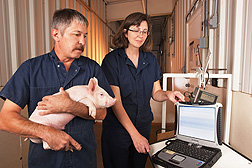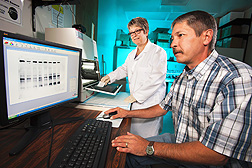Rooting Out a Novel Stress Syndrome in Pigs
Undergoing surgery, even a minor procedure, can be stressful for anyone. But for people who have malignant hyperthermia, a hereditary disease that’s triggered by certain drugs used for general anesthesia, it can also be dangerous.
Research into this rare, life-threatening condition, which causes a fast rise in body temperature, severe muscle contractions, and sometimes death, was limited until the discovery of a similar disorder in pigs, referred to as “porcine stress syndrome.” The classical syndrome is associated with poor response to stressors like transport and with poor-quality pork. It has been eliminated from commercial herds in the United States, but stress-related issues, most often associated with transportation, continue to cause substantial losses—an estimated $50 million per year—to the U.S. swine industry.
These issues indicate that there may be another stress-related syndrome affecting the health and well-being of pigs in the United States. In response to these concerns, scientists at the Agricultural Research Service’s Roman L. Hruska U.S. Meat Animal Research Center (USMARC) in Clay Center, Nebraska, have identified a previously undetected genetic stress syndrome that is most likely affecting the swine industry. They are mapping the defect in pigs to get to the root of the problem.
A Big Undertaking of a Huge Gene
Molecular biologist Dan Nonneman and his colleagues—geneticist Gary Rohrer, agricultural engineer Tami Brown-Brandl, and veterinary medical officer Shuna Jones—have mapped the stress disorder to a genetic mutation located in the dystrophin gene—the largest known gene in the mammalian genome.
“We believe this is the defect because we found that there’s about half as much dystrophin protein in affected pigs as there is in their normal siblings,” says Nonneman, who’s in the USMARC Reproduction Research Unit.
The syndrome was first discovered in two male siblings in the USMARC swine herd after they were transported from one facility to another at the center. Compared to their pen mates, the 3-month-old pair showed very atypical signs of stress—squealing, open-mouth breathing, skin discoloration, loss of mobility, and then death.
“This novel porcine stress syndrome is not a malignant hyperthermia like the classical stress syndrome; it’s a defect in dystrophin,” Nonneman says. “We hope to identify predictive markers that will allow us to determine the prevalence of this disease in commercial swine populations.”
Scientists re-mated the original sire (male) and dam (female) of the affected pigs to produce additional litters. At 8 weeks of age, the piglets underwent general anesthesia, and their heart rates and electrocardiographs (ECG) were monitored. Pigs identified as having the stress syndrome had abnormal ECG readings and sometimes died, whereas the heart rate of unaffected pigs remained steady. In some cases, piglets that did not undergo the anesthesia challenge were identified as having the stress syndrome when they had a stress response or died during typical procedures, such as weighing.
“We also looked at the enzyme creatine phosphokinase,” Nonneman says, “which is used to determine tissue damage after a heart attack. When muscle cells get damaged, this enzyme leaks out. Therefore, it’s used to monitor heart and other muscle diseases.”
Researchers found that creatine phosphokinase was about three times higher in pigs suspected of having the disorder.
“What we saw scattered throughout the muscle were regions with defects or injuries,” Nonneman says. “The whole muscle was not affected. The defect seemed to be interspersed throughout the tissue.”
Detecting the Defect
A critical issue was to identify a phenotype that could accurately determine whether pigs were affected or not. After several generations were produced from the original sire and dam—a pedigree of 250 offspring, including 49 affected pigs—scientists genotyped the animals using the Illumina Porcine 60K SNP Beadchip. A glass slide that contains thousands of DNA markers, the beadchip shows relationships between 60,000 markers simultaneously.
One chromosomal region containing the dystrophin gene was found to be associated with the syndrome.
“I won’t say that we have the mutation, but I think we have found the defective gene,” Nonneman says. “This syndrome maps to the dystrophin gene—DMD, which stands for Duchenne muscular dystrophy. DMD involves muscle weakness that worsens quickly and can lead to death under stressful situations.”
The gene is located on the X chromosome. The condition is found primarily in males because they inherit only one X chromosome from their mother, who has one normal and one affected X chromosome if she is a carrier. Males born to females that carry the disease each have a 50-percent chance of inheriting the syndrome.
“Diagnosing pigs with the disorder is difficult because female carriers do not seem to be affected,” Nonneman says. “Also, pigs that have the syndrome show no signs of the disorder unless they undergo stress.”
Piglets seem to be more susceptible when they are about 8 weeks old, an age when they are transported from nursery to grower facilities.
Useful in Muscular Dystrophy Research
The discovery of the defect may provide a unique biomedical model for cardiomyopathy—a heart muscle condition—associated with muscular dystrophy in humans, Nonneman says. Scientists at USMARC and Iowa State University are investigating the possibilities.
“Muscular dystrophy has a very wide range of severities and mechanisms as to how they occur,” Nonneman says. “There’s a lot of attention on developing therapies—some of which look very promising—for these diseases in humans. The pig provides critical information because of its similarities to human physiology.”
In the meantime, scientists are using next-generation sequencing technology, which produces millions of DNA sequences simultaneously, to completely sequence the chromosomal region in affected and normal animals and to identify all the DNA variation in dystrophin. The main goals are to identify the mutation, test as many commercial pigs as possible, find out how prevalent the new stress syndrome is, and develop strategies in cooperation with the pork industry to eliminate it from the U.S. pig population.
“We can use DNA markers to identify affected animals and then cull them out of the herds, choosing not to breed them. That’s what was done with the classic porcine stress syndrome,” Nonneman says.
Nonneman and his team plan to investigate whether the stress disorder affects meat quality as well as the growth and overall health of animals. They are also looking at cardiovascular effects in older pigs.—By Sandra Avant, Agricultural Research Service Information Staff.
This research is part of Food Animal Production, an ARS national program (#101) described at www.nps.ars.usda.gov.
Dan Nonneman is in the USDA-ARS Roman L. Hruska U.S. Meat Animal Research Center, State Spur 18D, Clay Center, NE 68933; (402) 762-4367.
"Rooting Out a Novel Stress Syndrome in Pigs" was published in the April 2013 issue of Agricultural Research magazine.








